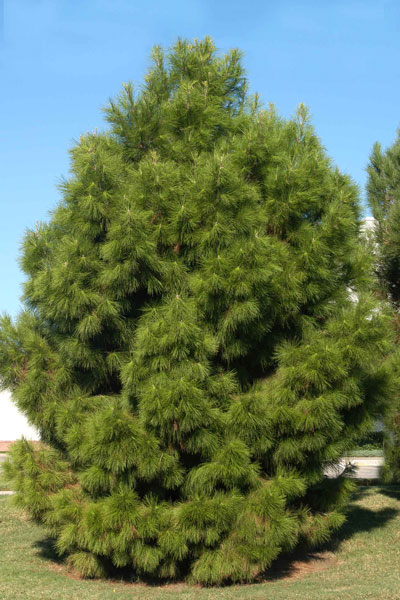A Tree to Enjoy, Then Plant Outdoors
If the concept of a living Christmas tree is appealing to you, I’ve brought a few of my favorites. But they may surprise you, and they do come with some warnings.
Let’s begin with the warnings…
• As growing conditions go, it’s very warm inside our homes. Living Christmas trees have been sitting in nurseries all fall, where temperatures have been stair-stepping downward. When we bring them indoors for a week or longer, they lose that preparation for winter’s cold. They can be damaged when we set them outside. Keep them indoors as short a time as you can.
• It’s very dry indoors. Your skin dries out. So do your plants. Keep them watered all the time, and again, minimize the time that they’re inside.
My recommendations of the best living Christmas trees…
Some of the ones you expected to find here won’t be on this list. They’ll show up later. These are the ones you’ll want to consider first, unusual as some may seem.

Forget the Leyland cypress trees in the foreground. They’re likely to develop disease problems. The durable eastern redcedar behind them is a long-proven native Texas Christmas tree.
• Juniper. It might be the prickly eastern redcedar or soft-textured (but erratically shaped) Hollywood twisted. It could be one of the other conical selections. Most junipers are well suited to Texas conditions.

Deodar cedar in McKinney is a stately conifer.
• Deodar cedar. This looks somewhat like a Colorado blue spruce, but it’s well suited to the southern half of the state. It does struggle with iron deficiency, so don’t plant it in shallow, highly alkaline conditions. (I’d still plant a juniper instead.)

False Japanese yew (Podocarpus) in Columbus, Texas, could easily be used as an outdoor tree at Christmas.
• False Japanese yew (Podocarpus). This is a rather upright plant with flat leaf blades a quarter-inch wide and several inches long. It needs partial shade in hotter parts of the state, and it’s not dependably winter-hardy in the northern half. (I’d still plant a juniper instead.)

This Nellie R. Stevens holly has obviously been sheared rather tightly, but it’s the perfect shape for decorating at Christmas.
• Upright holly such as Nellie R. Stevens, Willowleaf or Oakland. You can find these trained into a conical form. And, if you hang around with me very long, you already know that I’m in love with the hollies. But you have to think outside the lines if you choose one of these because they don’t look like your average Christmas tree.

Boxwoods come in all sizes. You develop their shapes.
• Boxwood. These can easily be sheared into Christmas tree form. Find a nice one this year and plant it into a decorative pot (drainage hole required). You can move it out onto the patio when Christmas has passed, keep it sheared, and reuse it for several years into the future. Protect it, however, if temperatures will drop into the low 20s.

Rosemary (upright form) can be trained into a tiny Christmas tree, then enjoyed during the growing season as well.
• Rosemary. You’ll see these sheared into small cones, and they, too, can be decorated and saved. Nice aroma as well, and you can pluck a few leaves for that fresh-from-the-garden flavoring for your Christmas dinner.
Then four you might not want to buy…
• Eldarica pine. I jumped on this plant’s bandwagon when they were introduced back in the 70s and early 80s, but they’ve gone off like grenades following wet years of 2007, 2015 and others. Diseases have caused them to wither and die, even in West Texas, unless they received perfect drainage. I cannot with a clear conscience recommend them, and I’ve seen other horticulturists pulling back their recommendations as well.

It’s a real shame that this pine from arid lands of Afghanistan can’t survive prolonged wet spells in Texas. Afghan (Eldarica) pine succumbs a year or two after record wet years unless it’s grown in extremely well-draining soils.
• Leyland cypresses. These looked like the perfect match. They’re beautiful, dark green and soft textured. But again, diseases wiped out big percentages of them across Texas following the wet years.
• Blue Point and Spartan junipers. I recommended eastern redcedar junipers just a few paragraphs ago, but these cousins have serious disease issues going on. Phomopsis is one of several that cause branches to die out, gradually ruining the looks of the plants. Stay with redcedars.
• Alberta spruces. Oh, please. Nice for a few months, but then summer arrives, and Texas and Alberta could not be less similar.
• Norfolk Island pines. These are tropical plants. They are unable to withstand any freezing weather at all, so for most of us, that translates into their being houseplants. They’re glorious looking initially – deliciously tempting. But then you read that they grow 75 feet tall in their native homes, and you think about which room in your house will have full sunlight and a 75-foot ceiling. It won’t matter, because they’re going to get lanky-ugly long before they get even 8 feet tall. This is one of the dozen or so plants on my “never again” list. My heart’s been broken too many times.
